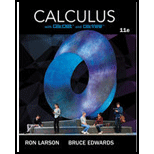P Preparation For Calculus 1 Limits And Their Properties 2 Differentiation 3 Applications Of Differentiation 4 Integration 5 Logarithmic, Exponential, And Other Transcendental Functions 6 Differential Equations 7 Applications Of Integration 8 Integration Techniques And Improper Integrals 9 Infinite Series 10 Conics, Parametric Equations, And Polar Coordinates 11 Vectors And The Geometry Of Space 12 Vector-valued Functions 13 Functions Of Several Variables 14 Multiple Integration 15 Vector Analysis expand_more
1.1 A Preview Of Calculus 1.2 Finding Limits Graphically And Numerically 1.3 Evaluating Limits Analytically 1.4 Continuity And One-sided Limits 1.5 Infinite Limits Chapter Questions expand_more
Problem 1E: Describing Notation Write a brief description of the meaning of the notation limx8f(x)=25. Problem 2E: CONCEPT CHECK Limits That Fail to Exist Identify three types of behavior associated with the... Problem 3E: Formal Definition of Limit Given the limit limx2(2x+1)=5 use a sketch to show the meaning of the... Problem 4E: CONCEPT CHECK Functions and Limits Is the limit of f (x) as x approaches c always equal to f(c)? Why... Problem 5E: Estimating a Limit Numerically In Exercises 5-10, complete the table and use the result to estimate... Problem 7E: Estimating a Limit Numerically In Exercises 5-10, complete the table and use the result to estimate... Problem 9E: Estimating a Limit Numerically In Exercises 5-10, complete the table and use the result to estimate... Problem 10E: Estimating a Limit Numerically In Exercises 5-10, complete the table and use the result to estimate... Problem 11E: Estimating a Limit Numerically In Exercises 11-18, create a table of values for the function and use... Problem 12E: Estimating a Limit Numerically In Exercises 11-18, create a table of values for the function and use... Problem 13E: Estimating a Limit Numerically In Exercises 11-18, create a table of values for the function and use... Problem 14E: Estimating a Limit Numerically In Exercises 11-18, create a table of values for the function and use... Problem 15E: Estimating a Limit Numerically In Exercises 11-18, create a table of values for the function and use... Problem 16E: Estimating a Limit Numerically In Exercises 11-18, create a table of values for the function and use... Problem 17E: Estimating a Limit Numerically In Exercises 11-18, create a table of values for the function and use... Problem 18E: Estimating a Limit Numerically In Exercises 11-18, create a table of values for the function and use... Problem 19E Problem 20E: Limits That Fail to Exist In Exercises 19 and 20, create a table of values for the function and use... Problem 21E: Finding a Limit Graphically In Exercises 21-28, use the graph to find the limit (if it exists). If... Problem 22E: Finding a Limit Graphically In Exercises 21-28, use the graph to find the limit (if it exists). If... Problem 23E: Finding a Limit Graphically In Exercises 21-28, use the graph to find the limit (if it exists). If... Problem 24E: Finding a Limit Graphically In Exercises 21-28, use the graph to find the limit (if it exists). If... Problem 25E: Finding a Limit Graphically In Exercises 21-28, use the graph to find the limit (if it exists). If... Problem 26E: Finding a Limit Graphically In Exercises 21-28, use the graph to Find the limit (if it exists).If... Problem 27E: Finding a Limit Graphically In Exercises 21-28, use the graph to find the limit (if it exists). If... Problem 28E: Finding a Limit Graphically In Exercises 21-28, use the graph to find the limit (if it exists). If... Problem 29E: Graphical Reasoning In Exercises 29 and 30, use the graph of the function f to decide whether the... Problem 30E: Graphical Reasoning In Exercises 29 and 30, use the graph of the function f to decide whether the... Problem 31E: Limits of a Piecewise Function In Exercises 31 and 32, sketch the graph of f. Then identify the... Problem 32E Problem 33E Problem 34E Problem 35E Problem 36E: Finding a for a Given The graph of f(x)=1x1 is shown in the figure. Find such that if 0x2, then... Problem 37E Problem 38E Problem 39E Problem 40E Problem 41E Problem 42E Problem 43E Problem 44E Problem 45E Problem 46E Problem 47E: Using the Definition of Limit In Exercises 45-56, find the limit L. Then use the definition to... Problem 48E Problem 49E Problem 50E Problem 51E Problem 52E Problem 53E Problem 54E Problem 55E: Using the Definition of Limit In Exercises 45-56, find the limit L. Then use the definition to... Problem 56E Problem 57E Problem 58E Problem 59E Problem 60E Problem 61E Problem 62E Problem 63E Problem 64E: Using the Definition of Limit The definition of limit on page 56 requires that f is a function... Problem 65E: Comparing Functions and Limits If f(2)=4, can you conclude anything about the limit of f (x) as x... Problem 66E Problem 67E: Jewelry A jeweler resizes a ring so that its inner circumference is 6 centimeters. (a) What is the... Problem 68E: Sports A sporting goods manufacturer designs a golf ball having a volume of 2.48 cubic inches. (a)... Problem 69E Problem 70E Problem 71E Problem 72E: HOW DO YOU SEE IT? Use the graph of f to identify the values of c for which limxcf(x) exists. Problem 73E Problem 74E Problem 75E Problem 76E Problem 77E Problem 78E Problem 79E: Evaluating Limits Use a graphing utility to evaluate limx0sinnxx for several values of n. What do... Problem 80E Problem 81E: Proof Prove that if the limit of f(x) as x approaches c exists, then the limit must be unique.... Problem 82E Problem 83E Problem 84E Problem 85E: Inscribe a rectangle of base b and height h in a circle of radius one, and inscribe an isosceles... Problem 86E Problem 6E: Estimating a Limit Numerically In Exercises 5-10, complete the table and use the result to estimate... Problem 8E: Estimating a Limit Numerically In Exercises 5-10, complete the table and use the result to estimate... format_list_bulleted


 Algebra & Trigonometry with Analytic GeometryAlgebraISBN:9781133382119Author:SwokowskiPublisher:Cengage
Algebra & Trigonometry with Analytic GeometryAlgebraISBN:9781133382119Author:SwokowskiPublisher:Cengage
